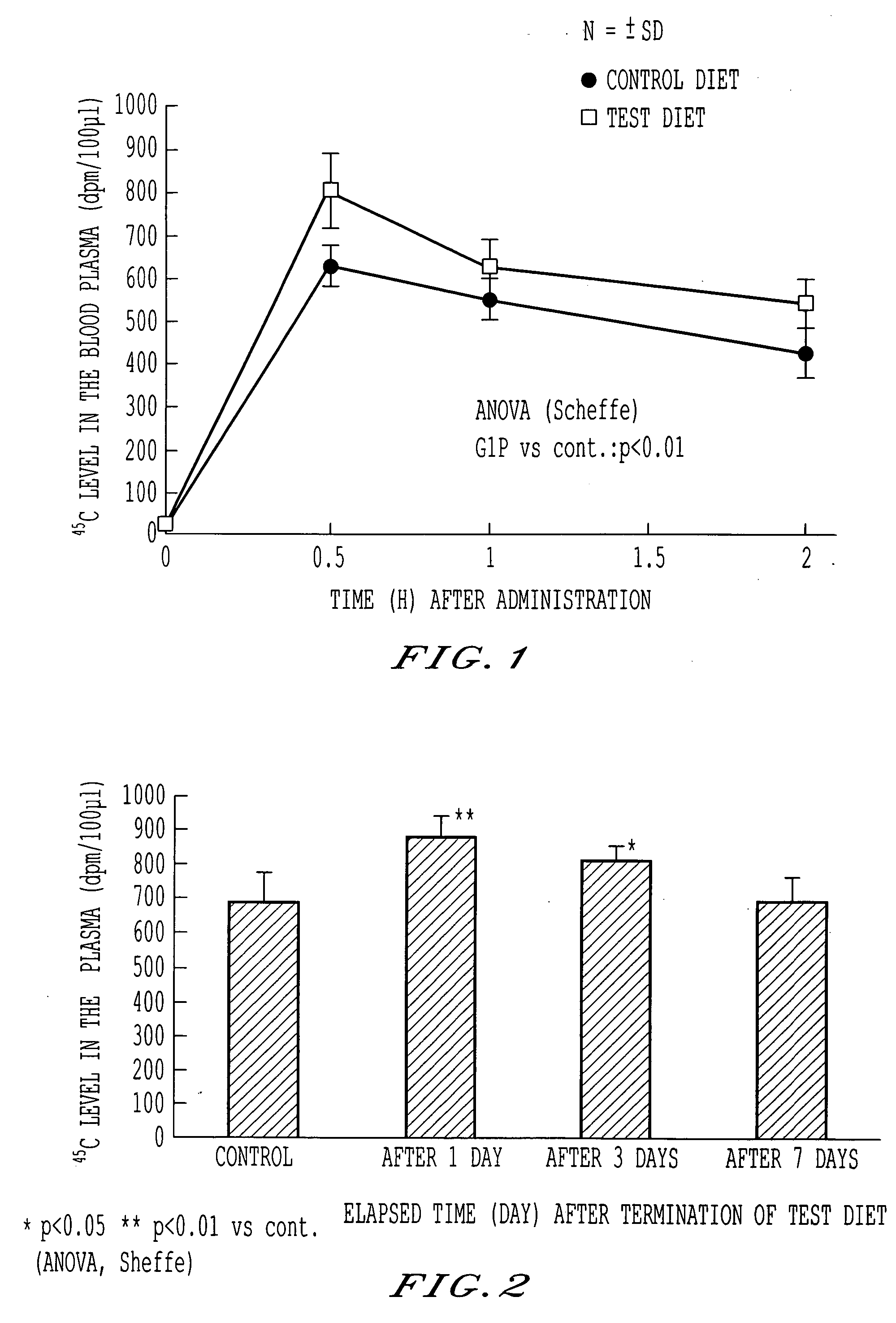Intestinal mineral absorption capacity improver
a mineral absorption and intestinal technology, applied in the direction of sweetmeat, food preparation, drug composition, etc., can solve the problems of insufficient absorption of inability to achieve the above-described effect, and inability to efficiently absorb minerals in the body, etc., to achieve the effect of improving the intestinal mineral absorption capacity
- Summary
- Abstract
- Description
- Claims
- Application Information
AI Technical Summary
Benefits of technology
Problems solved by technology
Method used
Image
Examples
example 1
Rats (8-week-old, male, SD rats), 10 rats consisting of one group, were each fed with 15 g / day of a control diet or a glucose 1-phosphate sodium salt diet as shown in Table 1 for 10 days. As the glucose 1-phosphate sodium salt, product of Solchem (Italy) was employed and the feed was adjusted to have a calcium concentration of 0.2 mass % and a P concentration of 0.4 mass %. The rats were allowed to take distilled water ad libitum.
After the rats were fasted for 24 hours, they were orally administered with 1.5 mL (containing 45CalμCi), per average weight, of a 1 mg / mL calcium chloride solution containing 45Ca singly. The blood plasma was obtained from about 0.5 mL of the blood collected from their carotid artery 30 minutes, 1 hour and 2 hours after administration. The 45Ca level in 100 μL of the blood plasma was measured by a liquid scintillation counter.
TABLE 1Composition of the feed (mass %)CompositionControl dietTest dietCasein20.0020.00DL-Methionine0.300.30α-Potato starch15.0...
example 2
Method
As in Example 1, 15 g / day of a control diet and a test diet as shown in Table 1 were fed to groups of rats (8-week-old, male, SD rats), each group consisting of 8 rats, for 10 days, respectively. The rat groups fed with the test diet were divided into three groups and as the feed after 10 days, the control diet was fed to each group and feeding of the glucose 1-phosphate sodium salt was terminated. The termination period was 1 day, 3 days and 7 days. The 45Ca level in the blood plasma after completion of the feeding period was measured in accordance with the method of Example 1.
Results
For 3 days after the feeding of glucose 1-phosphate sodium salt was terminated, the 45Ca level in the plasma showed a significant increase relative to the control group free of glucose 1-phosphate sodium salt. This suggests that the effect of glucose 1-phosphate sodium salt on mineral absorption enhancement continued for several days and frequent intake of glucose 1-phosphate sodium salt i...
example 3
A convenient food additive can be obtained by mixing 60 mass % of glucose 1-phosphate sodium salt with 40 mass % of dextrin and wrapping the mixture in wrappers, each 2 g, or forming the mixture into tablets, each 2 g, in a conventional manner. One wrapper of the mixture or one tablet is suited as an additive used upon cooking for one person.
PUM
 Login to View More
Login to View More Abstract
Description
Claims
Application Information
 Login to View More
Login to View More - R&D
- Intellectual Property
- Life Sciences
- Materials
- Tech Scout
- Unparalleled Data Quality
- Higher Quality Content
- 60% Fewer Hallucinations
Browse by: Latest US Patents, China's latest patents, Technical Efficacy Thesaurus, Application Domain, Technology Topic, Popular Technical Reports.
© 2025 PatSnap. All rights reserved.Legal|Privacy policy|Modern Slavery Act Transparency Statement|Sitemap|About US| Contact US: help@patsnap.com

